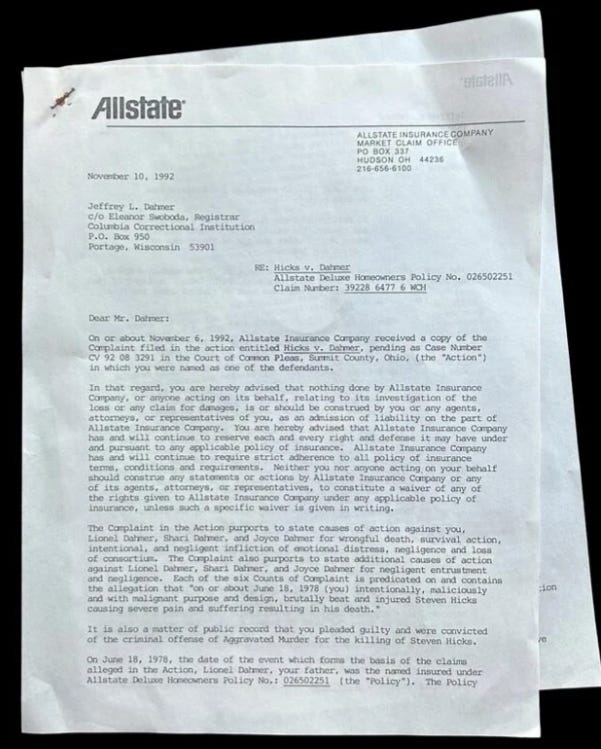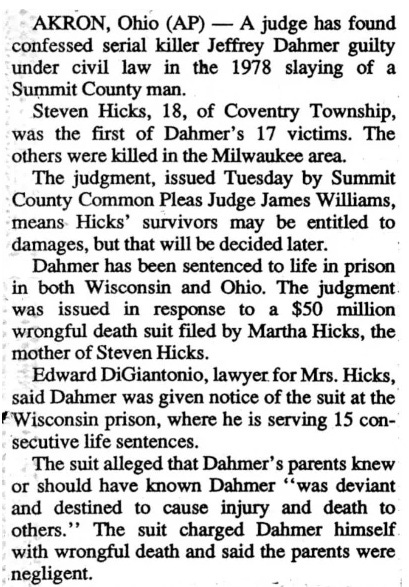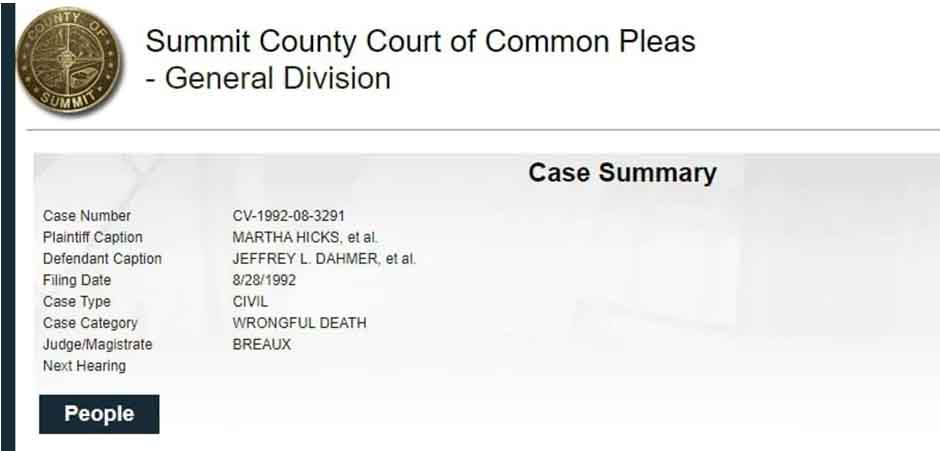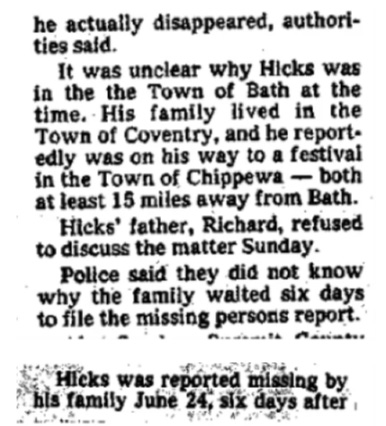Dumpster Diving Reveals Lionel, Shari, and Joyce Dahmer Were Implicated in What Happened to Steven Hicks in 1978
A very interesting 1992 Allstate Insurance claim
Someone digging in a dumpster outside Lionel Dahmer’s home recently found this 1992 letter to Jeff Dahmer from Allstate Insurance. It was then offered for sale on the website Cult Collectibles. It was a lucky find because it contains revealing information about what really happened to Steven Hicks in 1978:
In November 1992, the family of Steven Hicks filed a civil action against four people - Jeff Dahmer, Lionel Dahmer, Joyce Dahmer, and Shari Dahmer - for “wrongful death, survival action, intentional and negligent infliction of emotional distress, negligence and loss of consortium.”
There were additional causes of action against Lionel Dahmer, Shari Dahmer, and Joyce Dahmer for negligent entrustment and negligence.
The letter above was issued within days of Allstate receiving the complaint from the Hicks family. (The claim was made against Lionel's home insurer, Allstate, because home insurance policies provide cover for liability protection. A typical homeowners insurance policy provides liability coverage when someone not living with you is injured while on your property.)
Why is Shari Dahmer named in the lawsuit?
Note that at the time Steven Hicks died in June 1978, Shari Dahmer was not Lionel Dahmer’s wife. She married him in December 1978. However, she’s named in the lawsuit, which is curious.
Here are the legal definitions of wrongful death, survival action, intentional and negligent infliction of emotional distress, negligence, loss of consortium, and negligent entrustment:
Wrongful death - Wrongful death is a civil cause of action brought by family members and dependents against individuals who knowingly or negligently cause the death of another person. A wrongful death action may be brought against a person also facing criminal charges for the same event, and even if the person is not found guilty of a criminal charge, the person may be found liable for the wrongful death action because it has a lower burden of proof. The action is governed by state statutes which limit the damages and who can benefit from such suits. The statutes allow children and spouses to receive damages from wrongful death suits, but some states extend this to parents, siblings, and other dependents. Damages for wrongful deaths compensate for the lost financial support and suffering due to the death, and juries award damages based on a variety of factors including the person’s income beforehand, expected future income, and the level of family members dependence. Sometimes juries may award damages for funeral expenses, pain, and emotional harm caused to the person injured when they suffer before dying. Also, some states allow punitive damages to be awarded where the person causing the death does so out of intent or recklessness.
Survival action - A survival action is also a type of personal injury lawsuit that is filed on behalf of the victim and involves damages that the deceased individual would presumably have been entitled to had he or she survived their injuries. This type of legal action is usually filed in situations where a victim is injured by another party’s negligence, but survives the initial event only to succumb to their injuries later. It’s also used in medical malpractice lawsuits involving a gross medical oversight, surgical mistakes, or misdiagnosis that later leads to a patient’s untimely death. The greater the period of time between the initial injury and death, the stronger the case that the deceased individual’s family has for a survivor action lawsuit.
Intentional infliction of emotional distress - Intentional infliction of emotional distress (IIED) is a tort that occurs when one acts in a manner that intentionally or recklessly causes another to suffer severe emotional distress, such as issuing the threat of future harm.
Prima Facie CaseThe defendant acts
The defendant's conduct is outrageous
The defendant acts purposely or recklessly, causing the victim emotional distress so severe that it could be expected to adversely affect mental health
The defendant's conduct causes such distress
Negligent infliction of emotional distress - Negligent infliction of emotional distress (NEID) is a tort, defined as emotional distress caused by negligent action. States differ greatly as to when they allow a cause of action for NEID and exactly how damages are calculated, unlike intentional infliction of emotional distress (IIED). States mostly fall into three categories on how they allow NEID claims:
Most states allow NEID claims when the defendant’s actions were reasonably foreseeable to cause the emotional distress.
Some states only allow for an NEID claim when nearly missing physical harm and fearing such harm, termed being in a zone of danger.
For example, if someone assaulted a server, anyone sitting by the server could be in the zone of danger as they may have thought they were also going to be assaulted.
A few states require at least some physical injury to the plaintiff in order for NEID to be claimed at all.
Negligence - Negligence is the failure to behave with the level of care that a reasonable person would have exercised under the same circumstances. Either a person’s actions or omissions of actions can be found negligent. The omission of actions is considered negligent only when the person had a duty to act (e.g., a duty to help someone because of one’s own previous conduct).
Negligence is a foundational concept of tort law. Some primary factors to consider in ascertaining whether a person’s conduct lacks reasonable care are the foreseeable likelihood that the conduct would result in harm, the foreseeable severity of the harm, and the burden of precautions necessary to eliminate or reduce the risk of harm. The following five elements may typically be required to prove negligence:
The existence of a legal duty that the defendant owed the plaintiff
Defendant’s breach of that duty
Harm to the plaintiff
Defendant’s actions are the proximate cause of harm to the plaintiff
Defendant’s actions are the cause-in-fact of harm to the plaintiff
Loss of consortium - Loss of consortium refers to the loss or impairment of the intangible benefits of a relationship. When it is found that loss of consortium is caused by a tortfeasor, the victims’ loved ones may be able to recover reasonable damages arising from their loss of consortium. Loss of consortium claims were created in recognition that severe injury or death of a married person would cause great injury to their spouse.
Who may claim a loss of consortium?
The ability to sue for loss of consortium is governed separately by each state. Typically, states have opted to heavily restrict consortium claims. Siblings, friends, and extended family typically have no right to recover for loss of consortium, even if they were very close to the victim. Traditionally, consortium claims only applied to:
A widow or widower whose spouse was wrongly killed.
A wife or husband whose spouse was severely injured by a tortfeasor.
Unmarried couples are typically not able to bring a consortium claim, regardless of the length of time they have been together or the nature of their relationship.
Many jurisdictions now allow for parents to recover for loss of filial consortium, meaning the loss of consortium from their child. However, many states only allow filial consortium claims where the child was fatally injured. A minority of states also allow children to make a loss of consortium claim in instances where their parent(s) were wrongfully killed.
Negligent entrustment - The tort of negligent entrustment is based upon the principle that a person should not entrust a dangerous instrumentality to an unfit individual who may use it in a manner involving an unreasonable risk of harm to that individual or others. The “crux of the negligence is the knowledge of the entrustor of the youth, inexperience, known propensity for reckless and irresponsible behavior, or other quality of the entrustee, indicating the possibility that the entrustee will cause injury.”1 If the supplier of a dangerous instrumentality permits its use by a person that the supplier knows, or has reason to know, is unfit to have control over it, the supplier will be held accountable for all causally-related injuries to others.
The press article about the lawsuit stated that Jeff Dahmer's parents “knew or should have known” that Jeff was destined to cause injury and death to others:
But, as noted above, the lawsuit also named Shari Dahmer as a defendant. However, Shari Dahmer was not Jeff's parent. In fact, in June 1978, Shari Dahmer wasn’t even married to Lionel Dahmer. She was still Shari Shinn.
When the incident with Steven Hicks happened in June 1978 - whatever it was - Lionel Dahmer was still married to Jeff’s mother, Joyce Dahmer. Lionel and Joyce weren’t divorced until July 1978. Lionel Dahmer then married Shari Shinn in December 1978.
So, when this incident happened in June 1978 that resulted in the death of Steven Hicks, Shari Dahmer was nothing more than Lionel Dahmer’s girlfriend. She also wasn’t living in the house on Bath Road. She was staying with Lionel Dahmer in a motel down the road. Yet she’s named as a defendant in the lawsuit.
Why?
Here’s a video of Shari Dahmer “crying” on TV:
As noted above, the Allstate claim letter notes that there were additional causes of action made against Lionel, Shari (Shinn) and Joyce Dahmer for “negligent entrustment and negligence.” Here are the definitions of negligent entrustment:
Negligent entrustment is a cause of action in United States tort law which arises where one party ("the entrustor") is held liable for negligence because they negligently provided another party ("the entrustee") with a dangerous instrumentality, and the entrusted party caused injury to a third party with that instrumentality. The cause of action most frequently arises where one person allows another to drive their automobile.'
'One of the earliest reported cases under this cause of action, the 1915 Mississippi case of Winn v. Haliday, concerned the negligence of the father in entrusting a dangerous agency to a son known to be negligent, based on the allegation that the appellant knew his son to be given to 'joyriding'.
The key allegation that must be proven in such a case can be described as follows:
A plaintiff who invokes that doctrine must present evidence which creates a factual issue whether the owner knew, or had reasonable cause to know, that he was entrusting his car to an unfit driver likely to cause injury to others. Furthermore, in order to impose liability upon the owner, the plaintiff must prove that the negligent entrustment of the motor vehicle to the tortfeasor was a proximate cause of the accident.'
Negligence (Lat. negligentia*)*is a failure to exercise appropriate and/or ethical ruled care expected to be exercised amongst specified circumstances. The area of tort law known as negligence involves harm caused by failing to act as a form of carelessness possibly with extenuating circumstances. The core concept of negligence is that people should exercise reasonable care in their actions, by taking account of the potential harm that they might foreseeably cause to other people or property.
Someone who suffers loss caused by another's negligence may be able to sue for damages to compensate for their harm. Such loss may include physical injury, harm to property, psychiatric illness, or economic loss. The law on negligence may be assessed in general terms according to a five-part model which includes the assessment of duty, breach, actual cause, proximate cause, and damages.
Elements of Negligence
Some things must be established by anyone who wants to sue in negligence. These are what are called the "elements" of negligence.
Most jurisdictions say that there are four elements to a negligence action:
duty: the defendant has a duty to others, including the plaintiff, to exercise reasonable care,
breach: the defendant breaches that duty through an act or culpable omission,
damages: as a result of that act or omission, the plaintiff suffers an injury, and
causation: the injury to the plaintiff is a reasonably foreseeable consequence of the defendant's act or omission.
Some jurisdictions narrow the definition down to three elements: duty, breach and proximately caused harm. Some jurisdictions recognize five elements, duty, breach, actual cause, proximate cause, and damages. However, at their heart, the various definitions of what constitutes negligent conduct are very similar.
Proximate cause in this context means the primary cause. In law and insurance, a proximate cause is an event sufficiently related to an injury that the courts deem the event to be the cause of that injury.
So what brought forth the allegation of Negligent Entrustment?
What was Jeff negligently entrusted with by Lionel Dahmer, Shari Shinn, and Joyce Dahmer? One of the earliest cases under this cause of action involved “joyriding.”
Judge Rules in Favor of the Hicks Family
Judge James R. Williams ruled in favor of the Hicks family. So, Lionel Dahmer, Joyce Dahmer, and Shari Shinn Dahmer were all found guilty of these allegations.
How did the judge decide that the parents - and Shari Shinn Dahmer - knew or should have known Jeff was “deviant and destined to cause injury and death to others”? We don’t have the details of the decision. However, consider what Jeff Dahmer told Dr. Fosdal (see our previous post about Jeff Six.):
First mistake that led up to all this. Had I driven past, all this would not have happened.
That’s a rather strange statement coming from someone who, according to the official narrative, had supposedly been fantasizing about corpses and killing people since the age of 15. A person with such fantasies would have killed someone sooner or later anyway.
Did Steven Hicks’ parents know what really happened? Could it be that Steven Hicks was accidentally injured, and Jeff Dahmer panicked and didn’t call for help? That could explain a wrongful death suit. (Wrongful death lawsuits are based on a lesser burden of evidence than a criminal case).
News article reports note that Steven Hicks’ father was reluctant to discuss the anomalies in his son’s disappearance:
It should be pointed out that the same judge ruled on both the criminal and the civil suits.










It certainly does raise the question of why the parents, and Shari, were all accused and found guilty. Especially Shari. Joyce was still living at the house and did not leave until the end of August of 1978 (which Brian Masters mentioned in his book 'Shrine') contrary to the official story that we are told. Jeff was not left alone. Joyce could have been accused of complicity and cover up as she was still living at the house when Steven Hicks died. Was Jeff protecting her? In the 'confession', it also states that Jeff didn't meet Hicks until October 1978, but Jeff was at university by then. But Joyce had left the house by that time.
I just read the Allstate letter. The defendants were accused of brutally beating Hicks to death?
Shari seems a bit shady, IMO. Fake crying, fake name at the time of incident, etc. Possible marriage destroyer? Something seems off with her, IMO.